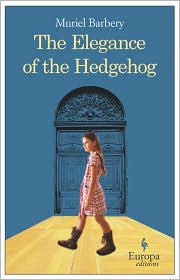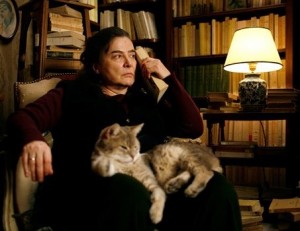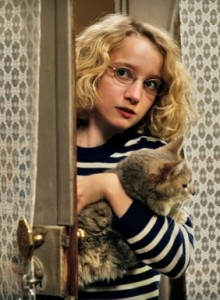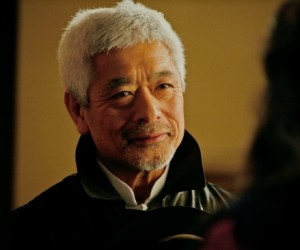“Madame Michel has the elegance of the hedgehog: on the outside, she’s covered in quills, a real fortress, but my gut feeling is that on the inside, she has the same simple refinement as the hedgehog: a deceptively indolent little creature, fiercely solitary—and terribly elegant.”
With sales of over hal f a million copies in Europe, this clever novel, newly released in the United States, may make Muriel Barbery as much of a literary phenomenon here as she is there, despite the novel’s unusual philosophical focus. The first narrator, Renee Michel, is a fifty-four-year-old woman who has been working for twenty-seven years as concierge of a small Parisian apartment building. Describing herself as a “proletarian autodidact,” she explains that she grew up poor and had to quit school at age twelve to work in the fields, but throughout her life she has been studying philosophy secretly, insatiable in her quest for knowledge about who she is and how she fits into the grand scheme of life.
f a million copies in Europe, this clever novel, newly released in the United States, may make Muriel Barbery as much of a literary phenomenon here as she is there, despite the novel’s unusual philosophical focus. The first narrator, Renee Michel, is a fifty-four-year-old woman who has been working for twenty-seven years as concierge of a small Parisian apartment building. Describing herself as a “proletarian autodidact,” she explains that she grew up poor and had to quit school at age twelve to work in the fields, but throughout her life she has been studying philosophy secretly, insatiable in her quest for knowledge about who she is and how she fits into the grand scheme of life.
Renee is grateful for her job as concierge, but she finds it prudent to keep her rich intellectual life hidden from the residents. Because she has no other future, she maintains the façade of the perfect concierge, someone who lives in a completely different world from them. She hides her books and even buys two TVs, keeping them turned on so that the residents will regard her as a typical, TV-watching employee.

Alternating with Renee’s thoughts about her life and the books she has been reading, are the musings of Paloma Josse, the twelve-year-old daughter of wealthy parents whose father is Minister of the Republic and whose mother, with a PhD in education, has an active professional life. Like Renee, Paloma pretends to be just average, carefully constructing her own façade so that she can fit in at school, though she has the intellectual level of a senior in college. With an older sister who torments her, Paloma is a child who has fallen through the cracks, ignored by her parents and within the school society in which she must pretend every day to be just average, a terrible strain. She has decided that on her thirteenth birthday, she will take the only path open to her: she will commit suicide, burning down her house at the same time.
 She has, however, given herself an “out.” She believes that beauty can elevate humans, and she is seeking “whatever is beautiful enough to give life meaning…If I find something, then I may rethink my options: if I find a body with beautiful movement or, failing that, a beautiful idea for the mind, well then maybe I’ll think that life is worth living.”
She has, however, given herself an “out.” She believes that beauty can elevate humans, and she is seeking “whatever is beautiful enough to give life meaning…If I find something, then I may rethink my options: if I find a body with beautiful movement or, failing that, a beautiful idea for the mind, well then maybe I’ll think that life is worth living.”
As the lives of Renee and Paloma unfold and sometimes overlap, the rough parallels in their lives become obvious, not just in their isolation and in their need to hide their talents but in the motifs that the author establishes. Nature and its concern with moments of perfect beauty, life, and death pervade the novel. In one hilariously ironic variation of this theme,  Neptune, a dog who lives in the apartment house, is observed by both Renee and Paloma as he discovers kairos, “the perfect moment”—when he mates vigorously with the whippet belonging to another resident, to the horror of the stodgy residents.
Neptune, a dog who lives in the apartment house, is observed by both Renee and Paloma as he discovers kairos, “the perfect moment”—when he mates vigorously with the whippet belonging to another resident, to the horror of the stodgy residents.
When one of the residents dies and his family decides to sell the apartment to a new owner, the novel reaches its turning point. Kakuro Ozu, whom Renee thinks may be related to the Japanese film maker that she most admires, moves in. All their lives change.
Barbery is a skilled writer with a great ability to combine the philosophy of Renee’s studies—from Husserl’s phenomenology, to determinism and Kant’s idealism—with aesthetics and the desire of both Renee and Paloma to find true beauty in art, poetry, and life itself. Always, however, she remembers that she is writing a story, with characters who must appeal to the reader. As Renee and Ozu become friends and as Paloma begins to identify with them and share confidences with Ozu, all change their views of who they are and what their lives might be.
By the time the novel ends,  the reader understands both the characters and the forces that have made them the people they are, hoping at the same time that all will manage to find happiness. Motifs from Japanese film and the novels of Tolstoy combine with images celebrating the perennial beauty of flowers (especially the camellia) and the connection of beauty with death, adding universality to the stories of these characters and connecting them to broader themes. Thoughtful, ironic, and often darkly humorous, the novel creates moods which bring the characters vividly to life, even as they are contemplating the deepest of life’s mysteries. (On my Favorites List for 2008.)
the reader understands both the characters and the forces that have made them the people they are, hoping at the same time that all will manage to find happiness. Motifs from Japanese film and the novels of Tolstoy combine with images celebrating the perennial beauty of flowers (especially the camellia) and the connection of beauty with death, adding universality to the stories of these characters and connecting them to broader themes. Thoughtful, ironic, and often darkly humorous, the novel creates moods which bring the characters vividly to life, even as they are contemplating the deepest of life’s mysteries. (On my Favorites List for 2008.)
Also reviewed here: Barbery’s GOURMET RHAPSODY
Credits: The author’s photo appears on http://babelio.wordpress.com/
The photo of Renee Michel (Josiane Balansko) is from the French film of this novel and appears on http://www.madman.com.au/actions/video.do?method=view&videoId=1940
The photos of Kakuro Ozu (Togo Igawa) and Paloma Josse (Garance le Guillermic) are also from the French film of this novel: http://www.cinemagia.ro/filme/le-herisson-471497/imagini/413234/
The wonderful video trailer of this film is here: http://www.madman.com.au/actions/video.do?method=view&videoId=1940
